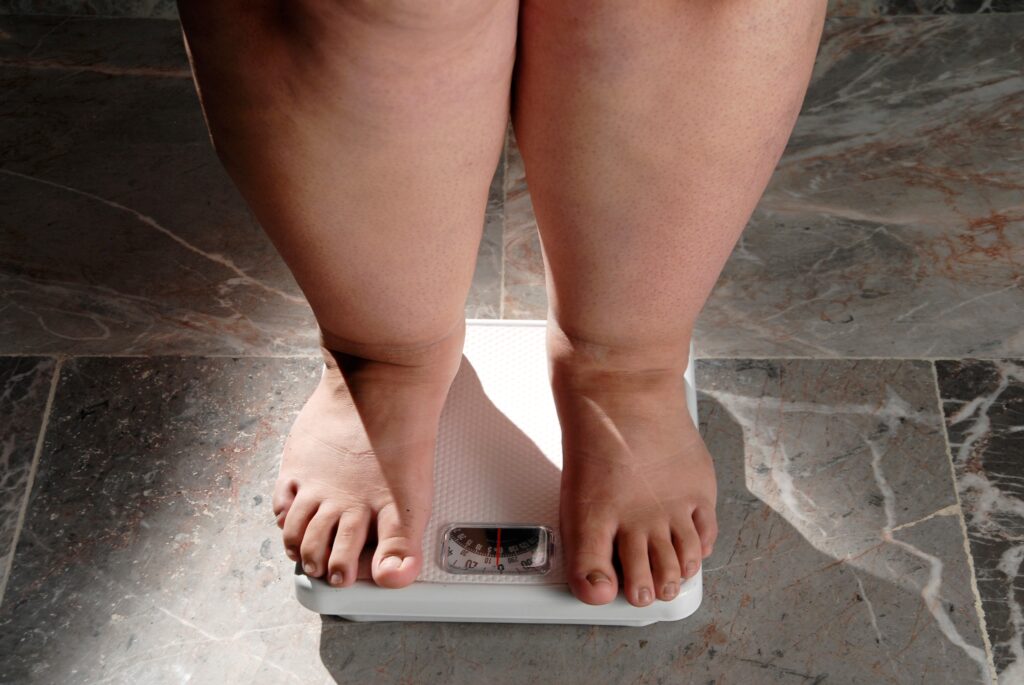How Obesity Hurts Feet
In 2017, the CDC identified that 41.7% of the American population was classified as obese. This raises concerns for numerous medical conditions. Foot pain, injury risk, and disorders are high on this list due to the pressure put on the foot to uphold the weight of the individual. Some of these conditions include fallen arches, tendonitis, heel pain, arthritis, pressure and swelling in the feet and ankles, weakening of the structure of the foot, and a heightened risk of serious injury.
Podiatrists are commonly found at bariatric surgery support groups or seminars explaining the risks that obesity plays on the structural integrity of the feet. Just one pound over your ideal weight can seriously impact pressure on your foot, and losing only five pounds can affect the foot as if you had lost 30 pounds. Walking up a flight of stairs, even without extra weight, is the equivalent of adding four to six times the pressure on your foot that walking on a flat surface creates. Obesity is a serious risk factor for injury to the feet.
What Defines Obesity?
Obesity is defined as having a body mass index that’s greater than 30. This not only poses a risk for feet, but it also increases the chances of developing other debilitating diseases, such as diabetes. Weight control is critical to preventing poor health outcomes and injuries. It’s not uncommon to find podiatrists and foot surgeons advocating for weight loss. Some won’t perform surgeries on the foot unless the patient has lost anywhere between 40-100 pounds.
How Do Feet Respond to Obesity?
One pound of body weight does not equate to one pound supported by the foot. It’s more equivalent to a weight of six pounds. Pair that with any added pressure through the angles that are involved when you climb stairs or walk on an incline, and that pressure is increased even further. So, it’s evident that the feet respond quite seriously to the effects of obesity.
Factors include:
- Weight distribution, which creates issues with balance and increases stress on the foot.
- This can cause increased pain and risk for a fracture or sprain.
- This can even impact the foot when walking.
- Diabetes is a huge risk for those who are obese. This has a drastic impact on overall health as well as feet.
- As you age, diabetes can reduce blood flow to the feet.
- This can lead to the loss of feeling, bruises, and sores.
- Infections become very high risk and common.
- As you age, diabetes can reduce blood flow to the feet.
- Plantar fasciitis is also very common in people who are obese. The added pressure on the joints, muscles, and tendons is unavoidable, thus triggering inflammation in the foot.
Risk Factors
Plantar Fasciitis
Although previously mentioned, there is more to discuss regarding plantar fasciitis and other risks that can complicate treatment and daily mobility. The swelling of the plantar fascia ligament, which connects the heel bone to the ball of the foot, is very common and often debilitating for those who work on their feet or walk a lot. The increased strain and pressure on the ligament can cause horrible pain, which isn’t easily alleviated.
Issues for Children
Children who suffer from obesity are also at a high risk of developing foot problems as they age and develop. The weight that their bones and muscles are supporting impacts their physical development. This also reduces their foot arch index and increases their risk of stress fractures, flat feet, and arch pain.
Self-Care Solutions
The most obvious first step anyone suffering from obesity can take is to seek a weight loss regimen that helps to alleviate the pressure on the foot. You can sometimes accomplish this without a doctor’s guidance, but if you feel you need something more serious, then contacting your local doctor for advice would be the first step.
Additional steps should include exercises to strengthen the foot muscles. This can consist of flexing your feet, rolling a ball or bottle under the arches of your foot while sitting, stretching your foot with a towel, and splaying your toes.
Lastly, always wear well-fitting shoes. You should never buy a shoe based on size, as sizes can vary by manufacturer. Your shoe size can also change as you get older, experience pregnancy, or even if you gain weight. Many factors can impact the entire structure of your foot, so it’s not safe to assume that you’re going to remain the same size throughout your life.
Try to ensure that you have the width of your finger or thumb between the end of your toe and the shoe while standing. You should also always replace your shoes when they become worn. The section of the shoe between your foot and the ground is the wear that you must pay attention to. If the shoe leans in any direction when you place it on a flat surface, then it’s time to replace your shoes.
Schedule an Appointment
If you would like to visit our offices to discuss any concerns about obesity and your feet, please feel free to schedule an appointment with Dr. Lisa Schoene or contact us on our website.

